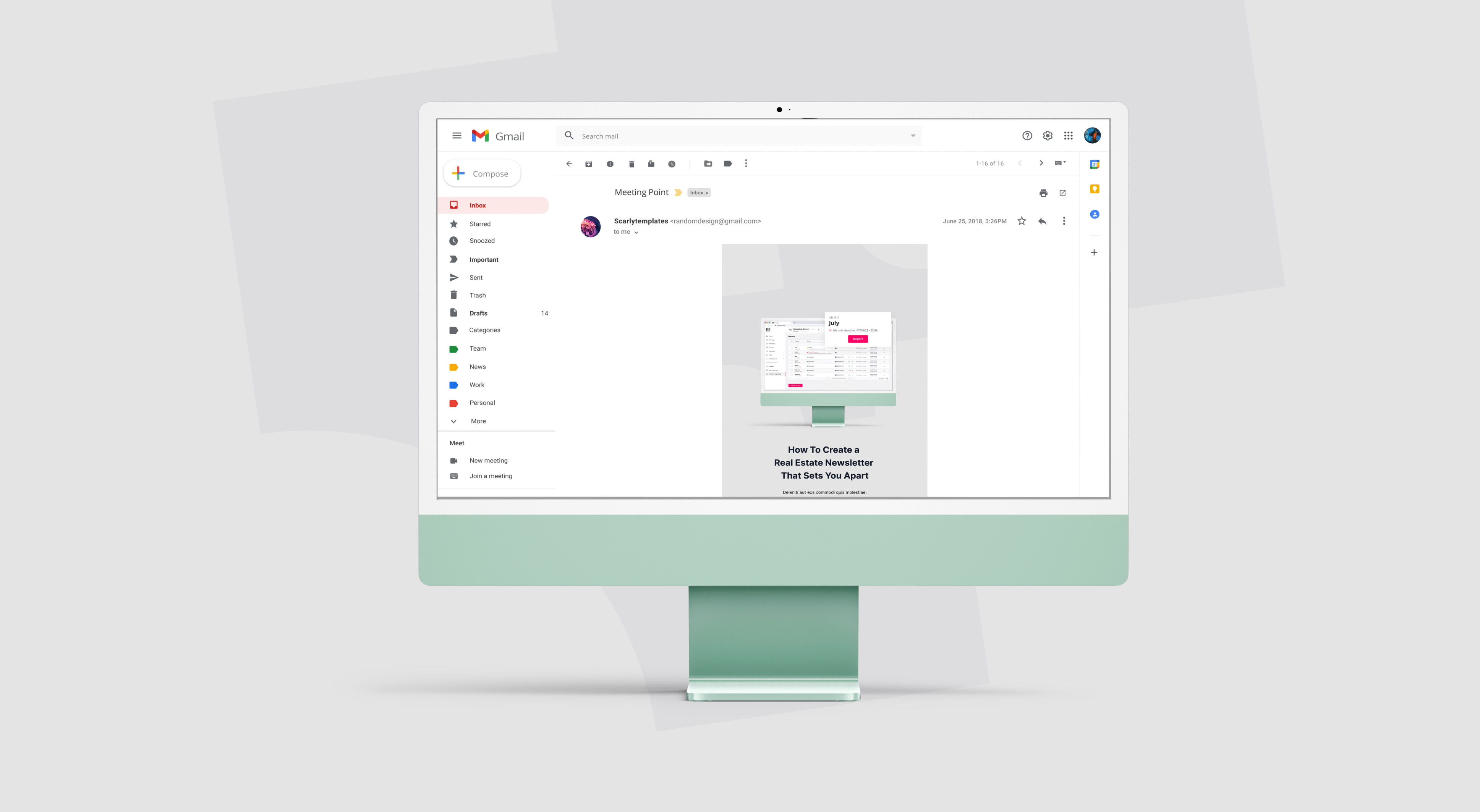CREtech London 2023: Top highlights from this year's event
Explore highlights from this year's CREtech event in London, where industry leaders discussed the intersection of technology, sustainability, and...
Looking to create a real estate newsletter that informs your tenants, attracts prospects and reinforces your brand? Read on to find out how.

The more informed your tenants are, the happier they’re likely to be. And happy tenants are easier to retain.
That’s why a real estate newsletter could be a valuable tool for retaining existing tenants and attracting prospects.
There are many reasons you might want to send out a real estate newsletter, including:
In this post, I outline some tips on how to create a real estate newsletter for any audience.
Let’s dive in!
1. Make use of your own expertise
2. Inform your tenant community with Chainels
3. Know your audience
4. Write a subject line that grabs attention
5. Think about formatting
6. Lead readers where you want them to go
7. Make it personal
Few people know the real estate industry better than you do. Use that authority to your advantage and craft stories from an expert lens.
For example, use internal data to write a mini-report on the latest trends, or leverage the knowledge of some of your more senior managers for thought leadership content.
If you’re looking to become an authority in your field, use your real estate newsletter as a platform for thought leadership.
Perhaps you or someone in your organisation is in a position to offer guidance and influence others through specialist expertise.
Thought leaders recognise trends before they happen, and draw on both the past, present and future to deliver key insights in a particular niche.
Becoming a thought leader doesn’t happen overnight, it takes time to build up credibility—but a real estate newsletter is a great place to start.
Showcase your existing content
As a real estate professional, you may have access to downloadable white-papers and reports —industry forecasts, sustainability reports or trend analyses.
But how is your audience supposed to know that they’re there in the first place?
A real estate newsletter is a valuable asset because it helps your audience access data and resources that they might not have otherwise.
A lot of work goes into those resources, so showcase yourselves as the authority that you are!
So a newsletter can do more than just keep your brand in the mind of prospects. Newsletters could go a long way in increasing tenant satisfaction and protecting your bottom line.
One way to use a real estate newsletter is to inform tenants about news and events happening within their community. If you’re able to keep existing tenants up to date, they’re more likely to see themselves as part of a community and less likely to churn.
Chainels is a tenant experience app for retail, residential, office and mixed use spaces where you can manage turnover and maintenance reporting, or offer extra services like bike rental and conference leasing.

Within the app—which can be white-labelled with your company’s own branding—you can send out newsletters to both tenants within your community and external contacts. You can build them too, adding your own imagery and brand colours.
By consolidating your tenant communication into one app, you can to reduce the amount of messages you send out by sending it all as a single newsletter. That's better than multiple different communications that could intrude upon, overwhelm or irritate your tenants.

Your real estate newsletter won’t have legs if you haven’t defined your audience before you send it.
Knowing the needs, desires, pain points and personalities of the people you want to reach is crucial. If you don’t know this, how are you going to get them to open the email in the first place?
Define beforehand what you want to achieve with your newsletter. Do you want to inform your existing tenants, attract leads and prospects, or position yourself as an authority within the industry?
Once you know your audience, you can be more strategic in what content you include in your real estate newsletter.
Pique interest with topical content
Populating your real estate newsletter with relevant, topical stories and informational content is essential for attracting engaged readers.
Once you know your audience, entice them with topics that matter to them, and information they can use.
Empathy is key here. Put yourself in the shoes of your audience. What’s troubling them? What might they need help understanding or clarifying?
This is what makes a real estate newsletter more than a simple round-up of news about your company.
Make it a useful resource which reinforces your brand’s authority. Follow trustworthy news sources for story on the latest industry news:
HousingWire
Yahoo! Finance
Financial Times
The Guardian
Wall Street Journal
Share tips relevant to your clients
Let’s be honest, most people scroll through their emails when they’re bored. It’s not necessarily somewhere people go to find specific information.
That doesn't mean however, that you can’t engage readers with some tips they can use when searching for a home, marketing their business, or dealing with difficult neighbours.
Marketing your residential assets? Offer tips on selling or buying homes.
What about retail tenants? Share tips on growing footfall, alternative revenue streams or how to make an attractive shop front.
Office clients? Share ideas for getting people back into the office, or how to find an optimal location for their business type.
Send it to the right people
Sending your email to wrong recipients will hurt your open rates, and could even come across as spam. It’s important therefore to segment your audience appropriately.
With Chainels, you can use labels to segment audiences into different audiences.
So if you’re sending topical news or event invites to attract prospects, you can label your contacts so it only sends to those marked ‘prospects’.
Or if you want to send out thought leadership content to your network, you can create a ‘network’ label and populate it with contacts who’d benefit from it.
These labels also let you control whether you send a newsletter to contact within or outside your tenant community.
Email subject lines are a crucial ingredient for any good real estate newsletter. Average click rate of real estate email campaigns is just 1.77%, some of the lowest of any industry, so it’s a detail that you shouldn’t overlook.
You can put hours into compiling, writing and designing a flawless email newsletter. If fall short on your subject line, users just won’t open it.
You therefore need a subject line that triggers people's curiosity and gets them to open. Easier said than done, right? Don’t worry, here are some tips to point you in the right direction.
Most of us don’t have time to read full sentences nowadays. If your subject lines are too lengthy, they’re not going to get noticed. Keep your subject lines under 140 characters for maximum impact.
Email spam filters detect email subject lines for particular words and send them to a user's spam folder if they find anything suspicious. Check out this list of spam filter words to avoid your real estate newsletter ending up as spam.
Your subject line should tell users what they gain from opening your email newsletter. This helps readers understand the value contained with your email newsletter, and they’re more likely to open.
For some reason, open ended questions are better to ask in email subject lines. If you ask a question that warrants an answer, users are more likely to open the email to get it.
Of course, make sure that your email newsletter is actually answering that question, otherwise users will feel cheated and won’t open your emails again.
Got big news to share? Include it in the subject line. News worthy stuff is always more interesting and if it’s truly newsworthy your users will be more likely to open it. Include the juiciest bits of news in your subject line.
Imagine receiving an email with big blocks of text like a school textbook. Are you going to read it? Neither is anyone on your email list.
If you want people to actually read your real estate newsletter, you need to make it easy to do so. You need to make it skimmable.
People don’t read emails like they read books or magazine articles. They gloss over a lot of the content, taking in only the most salient points, a lot like how people consume social media.
News outlets have cottoned onto this in recent years, their newsletters pack the big stories of the day into short digestible soundbites that can be glanced over by time-starved readers.
You should consider doing the same.
Ultimately, a retail newsletter is about communication.
Whether you’re bringing in prospects, informing existing tenants or striving to make a splash in your network—I hope you can use these tips to create something that not only communicates, but resonates.
Good luck!
Explore highlights from this year's CREtech event in London, where industry leaders discussed the intersection of technology, sustainability, and...
Discover real estate ESG frameworks in 2023 to enhance your real estate company's sustainability. Pros, cons, and a list of key frameworks are...
Discover the transformative power of tenant centricity in residential real estate management. Explore how this customer-focused approach is reshaping...